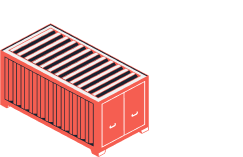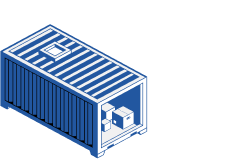Freight Shipping between Thailand and Netherlands | Rates – Transit times – Duties and Taxes
Imagine wrestling a Kraken while sailing the seven seas... Now, imagine that's what shipping goods from Thailand to the Netherlands might feel like if you're not prepared. The journey is often fraught with complexities, like decoding baffling freight rates, coping with unpredictable transit times, and grappling with stringent customs regulations. This guide is designed to weather that storm, providing insights into various freight options, including air, sea, road, and rail. We delve deep into the labyrinth of customs clearance, duties, taxes, and multiple procedures, providing tailored advice for businesses intending to revolutionize their logistics operations. If the process still feels overwhelming, let DocShipper handle it for you! We are an internationally acclaimed freight forwarder, turning your shipping challenges into triumphant successes with our comprehensive solutions. Embrace the adventure, leave the hardships to us!
Which are the different modes of transportation between Thailand and Netherlands?
When you're looking to transport goods from Thailand to the Netherlands, it's like picking the right horse for a long-distance race. Some horses, or in our case transport methods, better handle the marathon than others. Considering the 9000+ km voyage and multiple nations crossing, air and sea are your most practical choices. Going 'airborne' is faster but costs more, while the 'sea-route' is kinder to your budget but takes longer. It's all about matching these options with your specific ship needs - like delivery speed, cost, even the type and volume of goods you're moving. So, let's dive in.
Need help with your shipment?
Need assistance with your shipment? Dont hesitate to contact us even for a simple question. Choose the option that suits you
Live chat with an expert Chat on WhatsApp Free Quote 24hHow can Siam Shipping help you

Sea freight between Thailand and Netherlands
When it comes to shipping goods between Thailand and the Netherlands, ocean freight stands as a cost-effective and popular mode of transport, facilitating trade ties across their key ports, from Laem Chabang in Thailand to Rotterdam in the Netherlands. Renowned for its ability to carry high-volume goods, sea freight, despite its leisurely pace, ensures your inventory moves meticulously from one port to another. But let’s delve deeper.
We understand the labyrinth of complications you might encounter, from language barriers to unfamiliar trade regulations. It’s like trying to thread a needle in a haystack; one wrong move and you could end up in a shipload of problems. But there are strategies to turn the tide, specifications to guide you, and best practices to keep you on the winning side of the shipping game. This section aims to shed light on these aspects, smoothening your freight forwarding journey between these two trade-centric nations.
Main shipping ports in Thailand
Port of Laem Chabang
Location and Volume: Located in the Bang Lamung District, the port of Laem Chabang is paramount for its connection to Thailand’s Eastern Seaboard industries, boasting a remarkable shipping volume of close to 18 million TEU in 2022.
Key Trading Partners and Strategic Importance: The port’s key trading partners include China, Japan, and the United States, making it the cornerstone of Thailand’s economic connectivity with these vital trade markets.
Context for Businesses: If you’re envisioning a solid foothold in the Asian market, Laem Chabang should top your list, given its extensive shipping capacity and robust connections with key Asian economies.
Port of Bangkok
Location and Volume: Positioned along the Chao Phraya River, the Port of Bangkok, also known as Klong Toey, carries significant historic and economic weight. As Thailand’s primary port, it handled approximately 8,7 million TEU in 2022.
Key Trading Partners and Strategic Importance: The port enjoys robust trade relations with China, Japan, Malaysia, and Singapore. Its strategic location in Bangkok’s metropolis aids in swift goods transition, contributing greatly to the city’s hustle and bustle.
Context for Businesses: If rapid access to the heart of Thailand and seamless transfer of goods is your goal, the Port of Bangkok cannot be overlooked, owing to its advantageous location and excellent in-country connectivity.
Map Ta Phut Port
Location and Volume: Map Ta Phut Port is the largest port in Thailand in terms of cargo throughput, strategically located in Rayong province and serving as a key industrial gateway.
Key Trading Partners and Strategic Importance: It is heavily involved in international trade with major Asian economies, with freight mainly dealing in chemicals, petroleum, and agricultural products.
Context for Businesses: Map Ta Phut is an essential port to consider if your business revolves around trade in these fields, given its specialized facilities and infrastructure supporting the petrochemical industry.
Songkhla Port
Location and Volume: Set in the southern part of Thailand, Songkhla Port is a smaller, yet important hub, mainly for handling oil and gas cargo.
Key Trading Partners and Strategic Importance: As a member of the Southern Port Group, Songkhla services the Gulf of Thailand, with Indonesia and Malaysia as primary trading partners.
Context for Businesses: Companies in the energy sector may find Songkhla Port a key piece in their logistics puzzle, given its specialty in handling oil and gas commodities.
Sattahip Port
Location and Volume: Nestled 180 km southeast of Bangkok, Sattahip Port primarily caters to military logistics, with a substantial capability to handle commercial cargo.
Key Trading Partners and Strategic Importance: Currently, it extensively services intra-Asia trade routes, acting as a secondary launch point for overflow cargo from Laem Chabang.
Context for Businesses: If load diversification or additional routing flexibility is critical to your operations, then leveraging Sattahip Port offers potential advantages.
Sri Racha Port
Location and Volume: Located on the east coast of the Gulf of Thailand, Sri Racha Port mainly specializes in handling petroleum and related products.
Key Trading Partners and Strategic Importance: Its strategic positioning allows it to serve an array of trading partners bound for Thailand’s industrial zones.
Context for Businesses: If your operations align with petroleum or chemical products trading, Sri Racha Port forms an important fulcrum and allows smooth supply chain operations, given its distinctive capabilities.
Main shipping ports in Netherlands
Port of Rotterdam
Location and Volume: Located in the city of Rotterdam, the Rotterdam Port is the largest in Europe and an essential hub for global trade. With a shipping volume of over 220,7 million TEUs.
Key Trading Partners and Strategic Importance: The key trading partners include Germany, Belgium, the UK, Russia, and the USA. The strategic importance of this port lies in its highly efficient logistics services, massive infrastructure, and its essential role in Europe’s import/export activities.
Context for Businesses: If you’re looking to expand to European markets, the Port of Rotterdam can be an integral part of your logistics, given its exceptional connectivity to over 500 ports in more than 120 countries.
Port of Amsterdam
Location and Volume: Situated in the Dutch capital, Amsterdam, the Port of Amsterdam ranks as the second-largest port in the Netherlands and has a shipping volume exceeding 86 million tonnes annually.
Key Trading Partners and Strategic Importance: Major trading partners include Russia, Scandinavia, the UK, and Baltic Sea nations. Its strategic location and excellent hinterland connections hold considerable strategic importance, with particular attention to the energy industry.
Context for Businesses: If your business is in energy, biomass, or agricultural bulk, the Port of Amsterdam offers specialized facilities and a strategic geographical location for these sectors.
Port of Antwerp
Location and Volume: Located in Belgium, closely connected to the Dutch border, the Port of Antwerp is one of the largest ports in Europe, with a shipping volume exceeding 68,7 million TEUs.
Key Trading Partners and Strategic Importance: The key trading partners include the USA, Germany, the UK, and France. Its strategic value stems from comprehensive logistic and industrial facilities, making it an essential logistics hub for Europe.
Context for Businesses: If you’re shipping goods to Europe, particularly chemicals and petrochemicals, the Port of Antwerp’s dedicated facilities could make it an essential component in your shipping supply chain.
Port of Vlissingen
Location and Volume: The Port of Vlissingen is situated in the Netherlands’ southwestern region and handles a shipping volume of over 33,4 million tonnes annually.
Key Trading Partners and Strategic Importance: Major trading partners include countries like Germany, Sweden, and the UK. It holds strategic importance due to its short sailing times to major shipping routes and industrial facilities.
Context for Businesses: If your business involves minerals, vehicles, or agricultural products, the accessibility and storage facilities at the Port of Vlissingen can potentially optimize your logistics.
Port of Zeeland
Location and Volume: The Port of Zeeland is located in Vlissingen and Terneuzen. It handles over 34 million tonnes of goods annually, making it one of the leading ports in the Netherlands.
Key Trading Partners and Strategic Importance: Main trading partners include European countries such as Germany, Belgium, and France. Its strategic position in relation to Western Europe and excellent multimodal connections make it a critical link for many industries.
Context for Businesses: If your goods cater to the chemical and energy sectors, the Port of Zeeland’s proximity to Europe’s largest chemical cluster and excellent storage facilities could be a strong advantage.
Port of Moerdijk
Location and Volume: Located in North Brabant, the Port of Moerdijk is the fourth largest port in the Netherlands. It handled approximately 10,9 million tonnes of freight in 2022.
Key Trading Partners and Strategic Importance: Major trading partners are Germany and the UK. It’s recognized for its strong logistics network and the presence of various industries, including chemical and metal.
Context for Businesses: If your shipping strategy involves metal, chemical, or construction sectors, the presence of related industries at the Port of Moerdijk could facilitate your shipping procedures and offer potential synergies.
Should I choose FCL or LCL when shipping between Thailand and Netherlands?
Choosing between Full Container Load (FCL) and Less than Container Load (LCL) or ‘consolidation,’ for your sea freight from Thailand to the Netherlands is a strategic decision that can shape the success of your shipment. Each method has its benefits and trade-offs, affecting cost, delivery time, and the overall shipping experience.
By understanding these differences, you can make savvy, cost-effective decisions. Through the guidance that follows, you’ll get a handle on what these shipping options mean and how to select the one that fits your specific needs like a glove. Ready to dive in? Let’s get started.

Full container load (FCL)
Definition: FCL, an abbreviation for Full Container Load, is a type of ocean freight where a shipper rents the entire container - usually either a 20'ft or 40'ft container. When to Use: FCL shipping is best suited when your cargo volume exceeds 13CBM, 14CBM, or 15CBM. It's a sensible choice for large volume shipments due not just to the cost-effectiveness, but also for greater security as the container is sealed upon loading and remains so until arrival at its destination. Example: Let's say, a Thai manufacturer has to ship 500 boxes of clothes to a retailer in the Netherlands. They use an FCL container, providing them with a secure, cost-effective option for such a large shipment. Cost Implications: The cost of FCL shipping is often driven by the size of the container: whether it’s a 20’ft or a 40’ft. Despite higher initial costs for container hire, the FCL shipping quote per unit is typically lower as the volume increases; you’ll achieve economies of scale. Still, bear in mind that you pay for the whole container, regardless of whether it’s completely filled or not. The main takeaway is that FCL is a reliable and potentially cost-saving option for substantial loads.

Less container load (LCL)
Definition: Less than Container Load (LCL) shipping allows multiple shippers to share space within a single container. It's essentially a consolidation service where different cargos are brought together and shipped as one, with the cost split among shippers. When to Use: LCL freight is a fantastic option if your shipment falls below the half container mark, usually less than 13/14/15 CBM. This allows for increased flexibility since you only pay for the space you use, and more frequent shipping opportunities as you don't have to wait to fill up a container. Example: For instance, if a Bangkok-based ceramics company wants to send a batch of porcelain vases to Rotterdam yet only has 10 CBM of goods, an LCL shipment would be ideal. They'd share a container with other goods, lowering costs and reducing the waiting time. Cost Implications: While the LCL shipping quote might initially appear higher per unit than that of a Full Container Load (FCL), remember it's the cost-effectiveness for low-volume shipments that makes LCL attractive. The bill reflects the exact space used, making it a financially smart move for smaller, less bulky shipments.
Hassle-free shipping
Make shipping between Thailand and the Netherlands as smooth as sailing with DocShipper. Our ocean freight specialists understand your business needs. They'll help decipher whether consolidation or full container shipping is right for you based on your cargo volume, schedule, and budget. Don't let the complexities cast you adrift. Turn to DocShipper, and let our experts steer you towards the best shipping solutions. Get a free estimation today and set a course for smooth logistical waters.
How long does sea freight take between Thailand and Netherlands?
Sea freight between Thailand and the Netherlands typically takes around 29 to 36 days. However, remember that transit times depend on factors like the specific ports used, the weight, and nature of the goods. To get a more specific estimate, it’s always recommended to get in touch with a resourceful freight forwarder like DocShipper who can provide a tailored quote.
For a more comprehensive understanding, here’s a quick glance at the average transit times from main ports in both countries:
Thailand Port Netherlands Port Average Transit Time (Days) Laem Chabang Port of Rotterdam 33 Port of Bangkok Port of Amsterdam 32 Sriracha Harbour Port of Vlissingen 30 Sattahip Commercial Port Port of Groningen 34
*Please keep in mind this information is subject to change.
How much does it cost to ship a container between Thailand and Netherlands?
Container shipping costs between Thailand and the Netherlands can vary greatly, typically ranging from $50 to $500 per CBM. This broad spectrum in ocean freight rates depends on diverse factors like Point of Loading, Point of Destination, the carrier chosen, the nature of goods, and even monthly market fluctuations.
Giving an exact price up front isn’t feasible, but fear not, our seasoned shipping specialists are on deck to help. We quote on a case-by-case basis, ensuring you get the most favorable rates tailored to your specific shipping needs. Let us take the guesswork out of your shipping cost calculations!
Special transportation services
Out of Gauge (OOG) Container
Definition: OOG containers are designed specifically to suit items that can’t fit within the dimensions of standard shipping containers, making them perfect for out of gauge cargo.
Suitable for: This method is suitable for transporting large items such as heavy machinery, industrial equipment, and oversized loads.
Examples: For example, if your business is moving parts of a construction crane from Thailand to the Netherlands, an OOG container is likely your best fit.
Why it might be the best choice for you: As such, an OOG container might be the best choice for you if your goods exceed the dimensions of standard containers.
Break Bulk
Definition: Break bulk is a method where goods are loaded individually onto the ship, not in containers.
Suitable for: This alternative is ideal for cargoes too large or heavy to fit into containers, such as machinery, wood, or steel.
Examples: A business shipping industrial generators or steel beams would find this option quite beneficial.
Why it might be the best choice for you: If you have a loose cargo load that can’t be containerized, break bulk might be the optimum choice for your business.
Dry Bulk
Definition: Dry bulk refers to the shipment of unpackaged non-liquid commodities in large quantities.
Suitable for: Ideal for granular materials like coal, iron ore, grain, or sand.
Examples: For instance, a company exporting vast quantities of corn or rice from Thailand to the Netherlands can benefit from Dry bulk shipping.
Why it might be the best choice for you: If your business deals with large consignments of such goods, Dry bulk can provide a practical and economical shipping solution.
Roll-on/Roll-off (Ro-Ro)
Definition: A ro-ro vessel is a type of ship designed to carry wheeled cargo such as cars, trucks, or trailers that are driven on and off the ship on their own wheels.
Suitable for: This method is suitable for all types of self-propelling, towable, or forkliftable machinery and vehicles.
Examples: For instance, if you’re a car manufacturer shipping automobiles from Thailand to Netherlands, a ro-ro vessel would be an ideal choice.
Why it might be the best choice for you: If your business involves large, drivable machinery or vehicles, Roll-on/Roll-off can offer an efficient transport solution.
Reefer Containers
Definition: Reefer containers are refrigerated shipping containers used to transport goods requiring specific temperature control, such as fruits, meats, or pharmaceuticals.
Suitable for: Perfect for any goods that need to be kept fresh or frozen during shipping.
Examples: For instance, a seafood distributor could use a reefer container to ship prawns and crustaceans from Thailand to the Netherlands, maintaining freshness throughout the journey.
Why it might be the best choice for you: If your enterprise involves perishable goods requiring controlled temperature, reefer containers could ensure they are delivered in optimal condition.
Understanding which method of sea freight best suits your shipping needs can be challenging. This is where DocShipper comes in, with expert knowledge tailored to your specific freight forwarding needs. Reach out to us for a free shipping quote within 24 hours!

Air freight between Thailand and Netherlands
Air freight between Thailand and the Netherlands is like a swift stork carrying precious cargo on its wings – speedy, reliable, and perfect for small, high-value goods. Picture this: you’re a jeweler and need gemstones transported rapidly without a scratch – air freight is your safety net.
However, packing your goods onto the plane isn’t as simple as preparing a suitcase for vacation. Have you used the correct weight formula in estimating your shipping costs? Did you know oversight in this area could inflate your expenses? Likewise, a lack of knowledge about air freight best practices might end up costing you a pretty penny. But no worries – this guide guarantees a smooth takeoff and a perfect landing in eliminating these costly blind spots.





Contact Details for Customs Authorities
Thailand Customs
Netherlands Customs

Official name: Customs Administration of the Netherlands
Official website:www.aboutnetherlandscustoms.nl/
Certificate of Conformity (CE standard)
Shipping goods from Thailand to the Netherlands? A key document is the Certificate of Conformity to CE standard. This is much more than a quality assurance mark; it’s your green flag to the European market. Unlike the QA, which ensures product quality, the CE mark signifies compliance with the European safety, health, environmental, and protection legislations.
Consequently, CE marking is a mandatory requirement for selling products in the European Union, thus Netherlands. Think of it as similar to the U.S.’s FCC Declaration of Conformity. Your actionable insight? Ensure your product complies with CE standards before shipping to save time, avoid customs hitches, and maintain your firm’s reputation. Note though the UK uses UKCA marking instead post-Brexit. Look here for more: https://www.gov.uk/guidance/using-the-ukca-marking.
Get Started with Siam Shipping
Your first steps with Siam Shipping
Additional logistics services
Warehousing
Ensuring your stock stays safe across continents could be a logistical headache, even more so when specific conditions like temperature are vital. Imagine the relief of knowing chocolate from Thailand reaches the Netherlands still mouth-wateringly flawless! That's possible with the right warehousing partner. Exhale the storage stress and explore numerous solutions on our dedicated page: Warehousing.
Packing
Shipping between Thailand and the Netherlands? Proper packaging and repackaging is key! Having a reliable partner to ensure your goods, be it fine ceramics or pricey electronics, are shipped safely is essential. Imagine your antique Thai ceramics arriving intact, thanks to custom-designed wooden crates. Packaging matters! More info on our dedicated page: Freight packaging.
Transport Insurance
When shipping your goods, risks are just part of the journey. Yet, you can sleep easier with Cargo Insurance, which is your safety net against perils that can occur en route, unlike fire insurance that covers just one hazard. For instance, a container could topple at sea or be damaged during offloading. With Cargo Insurance, such risks are no longer your worry. Prevention is better than cure, after all. More info on our dedicated page: Cargo Insurance.
Household goods shipping
Relocating from Thailand to the Netherlands? It's not just about moving boxes, but about transferring a part of your life. From sizable sofas to delicate china, our team prudently wraps and packs your treasures, ensuring their safe voyage. Consider the real-world example of a family heirloom passed down through generations. Handing it to us means it reaches your new home undamaged.
Procurement in Thailand
Struggling with finding reliable suppliers overseas? DocShipper eases this process by sourcing and managing suppliers in regions like Asia and East Europe fitting your needs. They bridge the language gap and guide you through the complex procurement process. An example could be finding the right textile manufacturer in Thailand for your Dutch clothing line. For a deeper dive, check out our dedicated page: Sourcing services.
Quality Control
When shipping from Thailand to the Netherlands, ensuring your goods meet quality standards is crucial. Imagine ordering custom-made chairs, only to find they're faulty upon arrival in Amsterdam... A nightmare, right? By implementing quality inspections during manufacturing or customization, you evade such pitfalls. Our quality control service helps you dodge such setbacks, guaranteeing your products are up to the mark before the long haul. Dig deeper into how quality inspections can safeguard your shipment journey on our dedicated page: Quality Inspection.
Conformité des produits aux normes
When shipping goods, understanding compliance with destination regulations is crucial. Our Product Compliance Services are here to relieve you of this complex process. We'll test your products in our lab, ensuring they meet all necessary standards and requirements. Unnecessary customs hold-ups, fines, or re-shipments? Not on our watch! Explore this further on our dedicated page - Product compliance.






